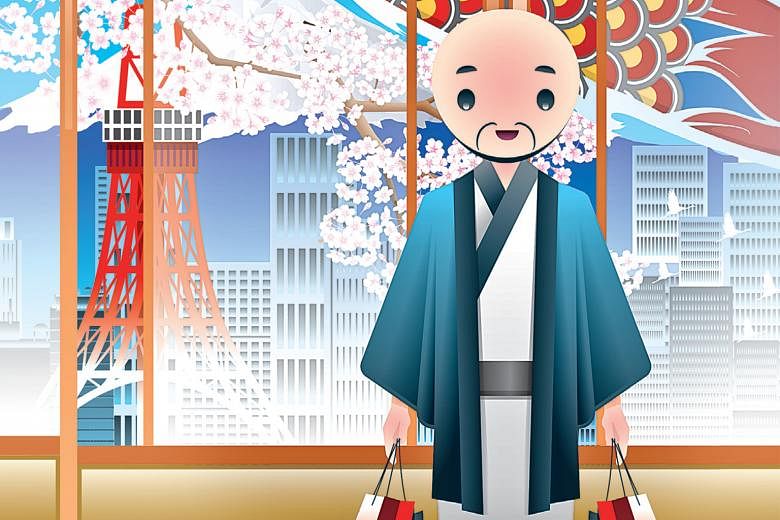This must be what Judgment Day feels like, I thought to myself.
A bright white light shone down on me, illuminating the uniformed official that hovered as I stood sheepishly at the counter.
I opened up the little red book that was in my hands.
Inside were small slips of white paper, a receipt for every sin I had committed during my long weekend in Tokyo.
Two indiscretions at Isetan Shinjuku - reckless and impulsive!

Three more at the Hankyu Men's sale - bad, bad, bad!
Two shirts, a tie and a pair of shoes at Dover Street Market - which could have been so easily avoided with moral fortitude and prayer.
The list went on and on. And as I stood there, carefully peeling each slip from my passport, I heard the familiar voices of my fellow countrymen.
"Wah liao, everyone has gone and we are STILL here doing this," said one young woman, as she counted her many misdemeanours one by one and her husband shook his head in amusement.
Then I spotted another traveller doing the same with his Singapore passport. And another, and another.
As we silently deposited our little slips into the grey tray of transgressions that spilled over, I glanced up at the official that was literally looking at his government's sales tax dollars slip away.
He was grinning from ear to ear.
Right at that moment, I understood why the Singapore retail scene is dying.
For those who aren't familiar yet with Japan's new system of retail self-flagellation, let me explain.
In October 2014, the Japanese government raised its sales tax (the equivalent of our GST) from 7 to 8 per cent. To pacify retailers that were worried that consumers would buy less, it started a new tax refund system for tourists.
The old system was the one you see in most other countries, including Singapore. If a tourist bought something in Tokyo from a shop that offered tax-free shopping, he would pay the amount (say 20,000 yen) plus the tax (in this case, 1,600 yen) at the cashier (21,600 yen in total). He would then claim the 1,600 yen at the airport before he left the country.
This is usually a consuming and sometimes nerve-racking ritual. In some countries, customs officials will want to inspect the goods before giving the tax refund.
After the rebate is granted, tourists have to go to another counter to receive the refund either in cash or in the form of a credit card rebate - minus a processing fee.
The whole process is often cumbersome enough to deter tourists from shopping too much. You often see long queues of frustrated-looking travellers arguing with surly customs officials, having to unpack their belongings in front of total strangers.
Frequent travellers to Japan have for years known that certain big department stores such as Takashimaya and Isetan processed the tax rebate in cash at the point of sale, eliminating the need to negotiate customs procedures at the airport.
But Japan's new system post-2014 is far better than that.
As long as it is a tax-free shop, you don't pay any sales tax at all when you buy something. In our example, it means you pay only 20,000 yen at the cashier.
The cashier then puts a little slip of paper in your passport to tell customs: We did not charge the 1,600 yen sales tax for the item (so don't come and claim it from us later).
Crucially, at the airport, customs does not even ask to see the items purchased.
When the new system first started, only a few shops offered tax-free shopping.
Now, almost two years later, tax-free shops are everywhere. At Recofan Shibuya, I was surprised to find that my stack of second-hand vinyl records - as cheap as 500 yen (S$6.60) each - would be tax-free. Even consumables such as food and drinks can be tax-free as long as a minimum of 5,000 yen is spent.
It's a simple initiative and the tax is only 8 per cent, but I can tell you that it works. For big-ticket items, the convenience of not paying tax at all was often the factor that made me pull the trigger.
For cheaper items, there was no thought process at all. The finger was on the trigger all the time, automatic weapon-style.
As I was happily accumulating little tax-free slips in my passport, I realised many of my former colleagues at the Ministry of Finance would have been aghast at the potential "tax leakage".
After all, if I were a Japanese resident, I could wait for an overseas friend to come to town and have him buy expensive items for me that would never leave Japan. In that way, I would avoid paying the sales tax I would normally have to pay as a resident.
For such a system to work, therefore, you would have to be reasonably sure that there will not be widespread abuse.
In Japan, this seems to be the case. I have never once seen a Japanese resident go up to tourists to ask them to buy something on his or her behalf at tax-free shops. Try it in China and the situation could be quite different.
More importantly, I think the Japanese government has calculated that even if there is abuse of the system, at least the net effect will be that more Japanese residents would end up buying goods in Japan and not from anywhere else.
This is an effect not to be sneezed at, especially in today's hyper-connected world.
Budget air travel has made it easier for Singaporeans to travel to pretty much every major shopping hub in Asia. In the past, consumers here compared prices between stores. Today, they compare across cities.
Add to that the advent of online shopping, which extends comparisons of price and range of goods beyond physical geography.
International delivery costs have come down dramatically and are sometimes as low as zero, whereas at physical stores in Singapore, consumers know that hidden in the mark-ups are high operating costs such as rent and manpower.
So there are very few reasons left for a Singapore consumer (or any consumer really) to shop in his own country. Especially not when it's often way too hot here to step outdoors and no one seems to be able to accomplish something as basic as air-conditioned walkways to link Orchard Road malls.
I think something must be wrong when someone like me visits Isetan Shinjuku more often than Isetan Orchard.
There are many other issues that need fixing to rescue the Singapore retail sector, such as the cookie-cutter character of our malls, which are filled with the same names selling the same goods.
During a recent business trip to Chicago, I stopped over in London for three days. In those 72 hours, I did not use a single penny. Whether it was train travel, Uber car rides, sandwiches for breakfast or sweets from the grocer, I would use my credit card or Apple Pay.
Singapore is a global city and plenty of people stop over or are here briefly on business.
Yet so many of our retail shops will not accept anything other than cash (which tourist wants to be saddled with Singapore dollars?) or Nets (which no global traveller can use).
Some strategic thinking and collective action are badly needed here if Singapore wants to keep its retail scene alive.
Otherwise we will be saying sayonara to it real soon.


